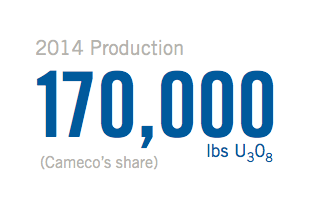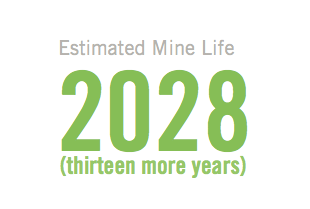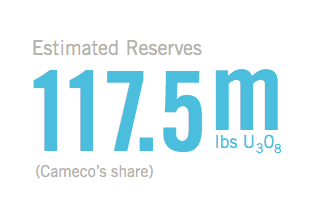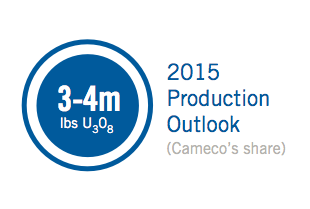Cigar Lake
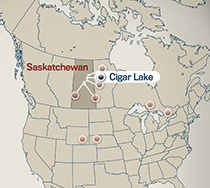
Cigar Lake is the world’s second largest high-grade uranium deposit, with grades that are 100 times the world average. We are a 50% owner and the mine operator.
Cigar Lake is one of our three material uranium properties.
| Location | Saskatchewan, Canada |
| Ownership | 50.025% |
| End product | Uranium concentrates |
| Mine type | Underground |
| Estimated reserves (our share) | 117.5 million pounds (proven and probable), average grade U3O8: 17.84% |
| Estimated resources (our share) |
2.3 million pounds (measured and indicated), average grade U3O8: 8.84% 52.5 million pounds (inferred), average grade U3O8: 16.22% |
| Mining methods | Jet boring |
| Planned capacity | 18.0 million pounds per year (our share 9.0 million pounds per year) |
| Licence term | Through June, 2021 |
| Total production (our share) | 0.2 million pounds |
| 2014 production (our share) | 0.2 million pounds (0.4 million pounds on 100% basis) |
| 2015 production outlook (our share) | 3.0 – 4.0 million pounds (6.0 – 8.0 million pounds on 100% basis) |
| Estimated decommissioning cost (100% basis) | $49 million |
Background
Development
We began developing the Cigar Lake underground mine in 2005, but development was delayed due to water inflows. In 2014, we started producing from the mine and processing of the ore began at AREVA’s McClean Lake mill. In October, 2014, the mill produced the first uranium concentrate from ore mined at the Cigar Lake operation.
Mining method and techniques
We will use a number of innovative methods and techniques to mine the Cigar Lake deposit:
Bulk freezing
The sandstone that overlays the deposit and basement rocks is water-bearing, with large volumes of water under significant pressure. We will freeze the ore zone and surrounding ground in the area to be mined to prevent water from entering the mine and to help stabilize weak rock formations.
We are using a hybrid freezing approach with a combination of underground and surface freezing, and are continuing to advance our surface freeze program to support future production. Through 2014, we continued to drill freezeholes from surface, expand the surface freezing infrastructure and put the new freezeholes into operation. To manage our risks and meet our production schedule, the area being mined must meet specific ground freezing requirements before we begin jet boring.
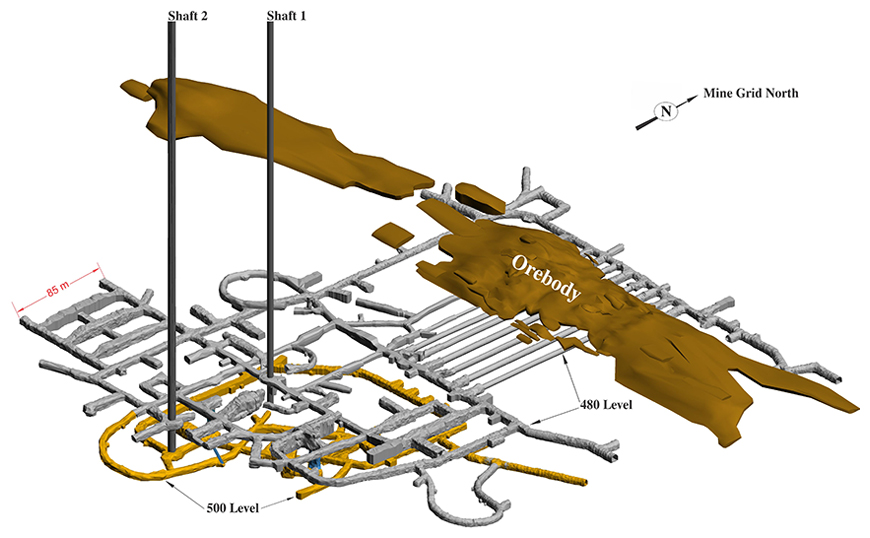
Jet boring
After many years of test mining, we selected jet boring, a non-entry mining method, which we have developed and adapted specifically for this deposit. This method involves:
- drilling a pilot hole into the frozen orebody, inserting a high pressure water jet and cutting a cavity out of the frozen ore
- collecting the ore and water mixture (slurry) from the cavity and pumping it to storage (sump storage), allowing it to settle
- using a clamshell, transporting the ore from the sump storage to a grinding and processing circuit, eventually loading a tanker truck with ore slurry for transport to the mill
- once mining is complete, filling each cavity in the orebody with concrete
- starting the process again with the next cavity
Jet boring system (JBS) process
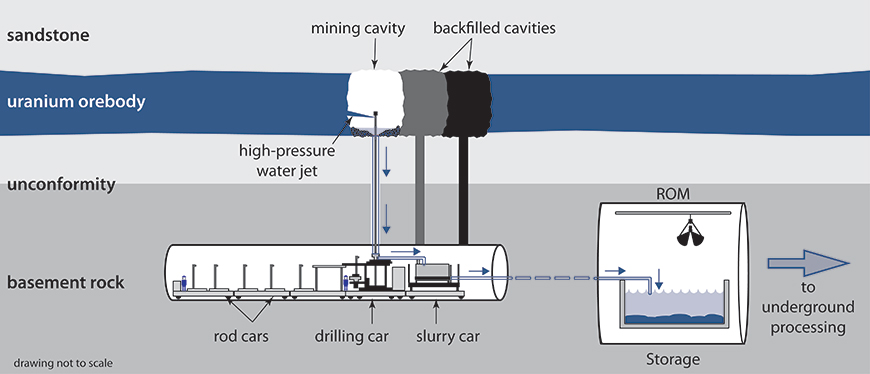
We have divided the orebody into production panels, and will have one jet boring machine operating in a panel; at least three production panels need to be frozen at one time to achieve the full production rate of 18 million pounds per year by 2018. In order to achieve our 2015 production target and continue ramping up the operation, three jet boring machines are required; all three are now on site. Later in the mine plan, we may require a fourth jet boring machine to sustain annual production of 18 million pounds.
Milling
All of Cigar Lake’s ore slurry will be processed at the McClean Lake mill, operated by AREVA. The McClean Lake mill is undergoing modifications and expansion in order to:
- operate at Cigar Lake’s targeted annual production level of 18 million pounds U3O8
- process and package all of Cigar Lake’s current mineral reserves
The Cigar Lake joint venture is paying for the capital costs for the modification and expansion.
2014 update
Production
Total production from Cigar Lake was 340,000 pounds; our share was 170,000 pounds.
During the year, we:
- brought the Cigar Lake mine into production
- began processing the ore at AREVA’s McClean Lake mill, which, in the fourth quarter, produced the first uranium concentrate from the Cigar Lake operation
- continued freezing the ground from surface to ensure frozen ore is available for future production years
Costs (all showing our share)
At the time of first production in March, 2014, we had:
- invested about $1.2 billion for our share of the construction costs to develop Cigar Lake
- expensed about $91 million in remediation expenses
- expensed about $111 million in standby costs
After production began in March, and to December 31, 2014, we spent:
- $83 million on the McClean Lake mill
- $16 million on standby costs, which were expensed, and ceased August 31, 2014
Additional expenditures of about $60 to $70 million will be required at McClean Lake mill in 2015 in order to continue ramping up to full production.
In addition, during the year, we spent:
- $57 million on operating costs
- $21 million to complete various capital projects at site
- $39 million on underground development
Some of the costs were capitalized, while others were charged to inventory, depending on the nature of the activity.
We will continue to capitalize some of the costs at Cigar Lake until such time that commercial production is reached. Commercial production is reached when management determines that the mine is able to produce at a consistent or sustainably increasing level.
Planning for the future
Production
In 2015, we expect to:
- begin commercial production
- have three jet boring machines operating underground
- continue ramping up towards the planned full production rate of 18 million pounds (100% basis) by 2018
Rampup schedule
We expect Cigar Lake to produce between 6 million and 8 million packaged pounds in 2015; our share is 3 million to 4 million pounds. Based on our operating experience and productivity during rampup, we will adjust our annual production plans as necessary to allow us to reach our full annual production rate of 18 million pounds (100% basis) by 2018.
Caution regarding forward-looking information
Our expectations and plans regarding Cigar Lake, including our expected share of 2015 production, achievement of the full annual production rate of 18 million pounds by 2018, and capital costs, are forward-looking information. They are based on the assumptions and subject to the material risks discussed here, and specifically on these assumptions and risks:
Assumptions
- our Cigar Lake development, mining and production plans succeed
- there is no material delay or disruption in our plans as a result of ground movements, cave-ins, additional water inflows, a failure of seals or plugs used for previous water inflows, natural phenomena, delay in acquiring critical equipment, equipment failure or other causes
- there are no labour disputes or shortages
- our bulk ground freezing program progresses fast enough to deliver sufficient frozen ore to meet production targets
- our expectation that the jet boring mining method will be successful and that we will be able to solve technical challenges as they arise in a timely manner
- our expectation that the third jet boring machine will be operational on schedule in 2015 and operate as expected
- we obtain contractors, equipment, operating parts, supplies, regulatory permits and approvals when we need them
- modification and expansion of the McClean Lake mill is completed as planned and the mill is able to process Cigar Lake ore as expected, AREVA will be able to solve technical challenges as they arise in a timely manner, and sufficient tailings facility capacity is available
- our mineral reserves estimate and the assumptions it is based on are reliable
Material risks
- an unexpected geological, hydrological or underground condition or an additional water inflow, further delays our progress
- ground movements or cave-ins
- we cannot obtain or maintain the necessary regulatory permits or approvals
- natural phenomena, labour disputes, equipment failure, delay in obtaining the required contractors, equipment, operating parts and supplies or other reasons cause a material delay or disruption in our plans
- sufficient tailings facility capacity is not available
- our mineral reserves estimate is not reliable
- our development, mining or production plans for Cigar Lake are delayed or do not succeed for any reason, including technical difficulties with the jet boring mining method or freezing the deposit to meet production targets, the third jet boring machine does not go into operation on schedule in 2015 or operate as expected, technical difficulties with the McClean Lake mill modifications or expansion or milling Cigar Lake ore
Managing our risks
Cigar Lake is a challenging deposit to develop and mine. These challenges include control of groundwater, weak rock formations, radiation protection, water inflow, mining method uncertainty, regulatory approvals, tailings capacity, surface and underground fires and other mining-related challenges. To reduce this risk, we are applying our operational experience and the lessons we have learned about water inflows at McArthur River and Cigar Lake.
Jet boring mining method
Although we have successfully demonstrated the jet boring mining method in trials and initial mining to date, this method has not been proven at full production and we continue with commissioning work to determine if the method is capable of achieving the designed annual production rate. Mining has been completed on a limited number of cavities that may not be representative of the deposit as a whole. As we ramp up production, there may be some technical challenges, which could affect our production plans including, but not limited to, variable or unanticipated ground conditions, ground movement and cave-ins, water inflows and variable dilution, recovery values and mining productivity. There is a risk that the rampup to full production may take longer than planned and that the full production rate may not be achieved on a sustained and consistent basis. We are confident we will be able to solve challenges that may arise, but failure to do so would have a significant impact on our business.
We brought the mine into production using one jet boring machine. To reach our 2015 production target and the full production rate of 18 million pounds per year by 2018 (100% basis), our mine plan requires three jet boring machines. We currently have all three machines on site, with two in operation underground and the third expected to be in operation underground in 2015. We are assessing whether a fourth jet boring machine will be required to sustain annual production of 18 million pounds, later in the mine life.
Ground freezing
To manage our risks and meet our production schedule, the areas being mined must meet specific ground freezing requirements before we begin jet boring. We have identified greater variation of the freeze rates of different geological formations encountered in the mine, based on new information obtained through surface freeze drilling. As a mitigation measure, we have increased the site freeze capacity to facilitate the extraction of ore cavities as planned.
Mill modifications
There is a risk to our plan to achieve the full production rate of 18 million pounds per year by 2018 if AREVA is unable to complete and commission the required mill modification and expansion on schedule. We are working closely with AREVA to understand and help mitigate the risks to ensure that mine and mill production schedules are aligned.
Water inflow risk
A significant risk to development and production is from water inflows. The 2006 and 2008 water inflows were significant setbacks.
The consequences of another water inflow at Cigar Lake would depend on its magnitude, location and timing, but could include a significant delay or disruption in Cigar Lake production, a material increase in costs or a loss of mineral reserves.
We take the following steps to reduce the risk of inflows, but there is no guarantee that these will be successful:
- Bulk freezing: Two of the primary challenges in mining the deposit are control of groundwater and ground support. Bulk freezing reduces but does not completely eliminate the risk of water inflows.
- Mine development: We plan for our mine development to take place away from known groundwater sources whenever possible. In addition, we assess all planned mine development for relative risk and apply extensive additional technical and operating controls for all higher risk development.
- Pumping capacity and treatment limits: We have pumping capacity to meet our standard for this project of at least one and a half times the estimated maximum inflow.
We believe we have sufficient pumping, water treatment and surface storage capacity to handle the estimated maximum inflow.
We also manage the risks listed here.

